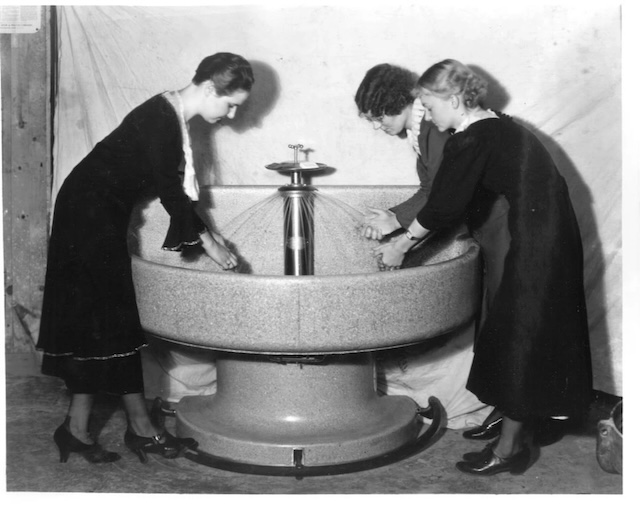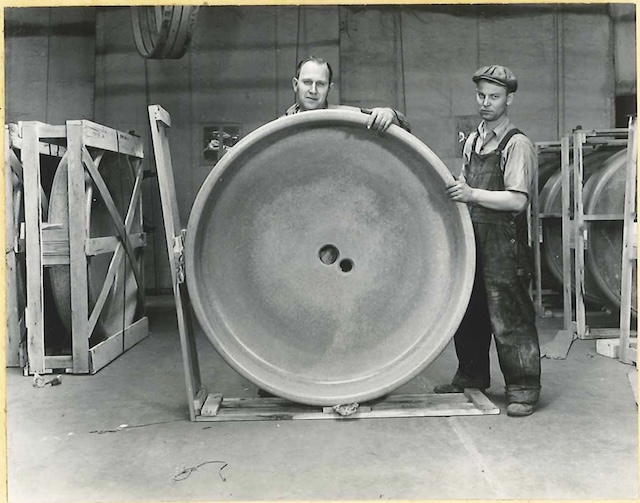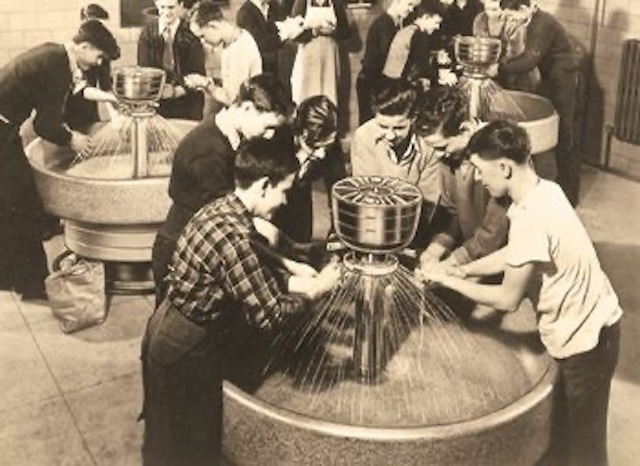For many who grew up in the mid-20th century, the image of a communal hand-washing fountain evokes fond memories of school days, gym classes, and public spaces. These hand-washing stations were once a ubiquitous feature in schools, factories, and public restrooms, standing as a symbol of practicality and communal hygiene. Though they may seem like relics of a bygone era, the communal hand-washing fountain was once a cornerstone of public hygiene. This article will explore its history, design, and eventual decline, shedding light on its legacy and significance in modern-day public health practices.

The Birth of the Handwashing Fountain
The communal hand-washing fountain was born out of a need for efficiency in large public spaces during the early to mid-20th century. With the rapid expansion of schools, factories, and other communal environments, it became increasingly important to address hygiene concerns in a practical and timely manner. Prior to this innovation, washing hands was a much slower and more individual process, often requiring long lines at sinks and taps. The communal fountain provided a solution to these issues by allowing multiple people to wash their hands at once.
Its design was simple yet effective: a central column from which water spouted in multiple directions, creating a circular flow of water that allowed several individuals to use the fountain simultaneously. Typically, soap dispensers were installed nearby, and water could be activated by a simple lever or foot pedal. This setup not only facilitated speed but also minimized the need for touching individual taps, making it more hygienic than traditional sinks.

How It Worked: A Glimpse into Efficiency
At first glance, the communal hand-washing fountain may seem antiquated, but its design was rooted in efficiency. These fountains were particularly useful in environments like schools, where large groups of people needed to wash their hands quickly between classes or after recess. The beauty of the design lay in its simplicity. The central column allowed multiple people to stand around it, each using a small stream of water to rinse their hands simultaneously. This design was far more efficient than individual sinks, which were often in short supply or required more time to operate.
Additionally, the water flow was controlled to minimize waste, an important consideration in an era when water conservation was a growing concern. The water flow would cascade gently from the central column in an arc, allowing users to rinse their hands without splashing. At the same time, the basin at the fountain’s base would catch the runoff, keeping the surrounding area clean and dry.
One of the key hygiene benefits of the communal fountain was its design, which minimized contact with surfaces. In a time when hygiene was a growing concern, the fountain reduced the number of surfaces people needed to touch, limiting the spread of germs. For many years, the communal hand-washing fountain was a practical solution to public hygiene, especially in places where time and space were limited.

The Rise in Popularity
From the 1940s through the 1970s, communal hand-washing fountains became a popular fixture in schools, factories, and public restrooms. They were favored for their ability to accommodate large numbers of people quickly and efficiently. Schools, particularly those with large gymnasiums or cafeterias, were quick to adopt the communal fountain as a solution to the problem of getting students to wash their hands quickly between activities.
Not only were they effective in terms of time management, but they also saved water compared to the use of individual faucets. This made them a cost-effective solution for public institutions trying to manage resources more carefully. Furthermore, the design of these fountains was relatively simple, making them easy to install and maintain, contributing to their widespread popularity.
Nostalgia and Memories
For many who grew up during the mid-20th century, the communal hand-washing fountain holds a special place in their memories. It was more than just a functional piece of equipment; it was a part of daily life in schools, where it served as a gathering point for students. Whether it was after gym class or during lunch break, the communal hand-washing fountain often became a place to chat, laugh, and socialize with friends.
These memories are vivid for many adults who recall the sounds of the water spraying, the feeling of cool water on their hands, and the camaraderie of washing up with classmates. For these individuals, the communal hand-washing fountain represents a simpler, more communal time, where hygiene was both a personal and collective experience.

Challenges and Decline
Despite its popularity, the communal hand-washing fountain was not without its challenges. One of the primary concerns was hygiene. Although the design reduced the need for touching individual taps, there were still shared elements, such as soap dispensers and handles, which could become breeding grounds for bacteria. In crowded public spaces like schools, where germs spread rapidly, this was a significant issue.
As public health standards evolved in the 1980s and 1990s, more emphasis was placed on reducing cross-contamination. This shift led to the decline of communal hand-washing fountains, as people began to demand more hygienic solutions. New technologies, such as motion-activated faucets and individual sinks, were introduced to minimize physical contact with surfaces, which made the communal fountains seem outdated.
The Decline of the Hand-Washing Fountain
By the late 20th century, the communal hand-washing fountain had largely fallen out of favor. As schools, factories, and public buildings underwent renovations and redesigns, these fountains were often replaced with more modern, hygienic solutions. Individual sinks with automatic faucets, soap dispensers, and air dryers became the standard in public restrooms, offering a more personalized and hygienic experience.
In many cases, the removal of communal fountains marked the end of an era. What was once seen as an efficient and innovative solution to public hygiene became a relic of the past. Today, it’s rare to find a communal hand-washing fountain still in use, though some may remain in older buildings or hidden corners of public institutions.

The Legacy of the Handwashing Fountain
Although the communal hand-washing fountain is no longer a common sight in public spaces, it continues to hold a special place in the memories of those who grew up with it. Today, vintage enthusiasts and collectors find these fountains fascinating, not just for their unique design but for their historical significance. They serve as a reminder of a time when public hygiene solutions were focused on efficiency and communal use.
In a world where personal space and hygiene are more important than ever, it’s interesting to look back at the communal hand-washing fountain as a precursor to modern hygiene solutions. It represents an era when the design of public spaces prioritized efficiency, practicality, and shared experiences. The fountain may have been replaced by more advanced technology, but its legacy remains a testament to the ingenuity of its time.
Conclusion
The communal hand-washing fountain, once a staple in public restrooms and schools, is a relic of a bygone era. Its efficiency and practicality made it an essential part of public hygiene during the mid-20th century, but changes in hygiene standards and public health practices led to its decline. Despite its disappearance, the hand-washing fountain continues to hold nostalgic value for many and serves as a reminder of a simpler time when communal hygiene was a priority. As we continue to innovate and improve public health systems, the legacy of the hand-washing fountain remains an important chapter in the history of public design and hygiene.

